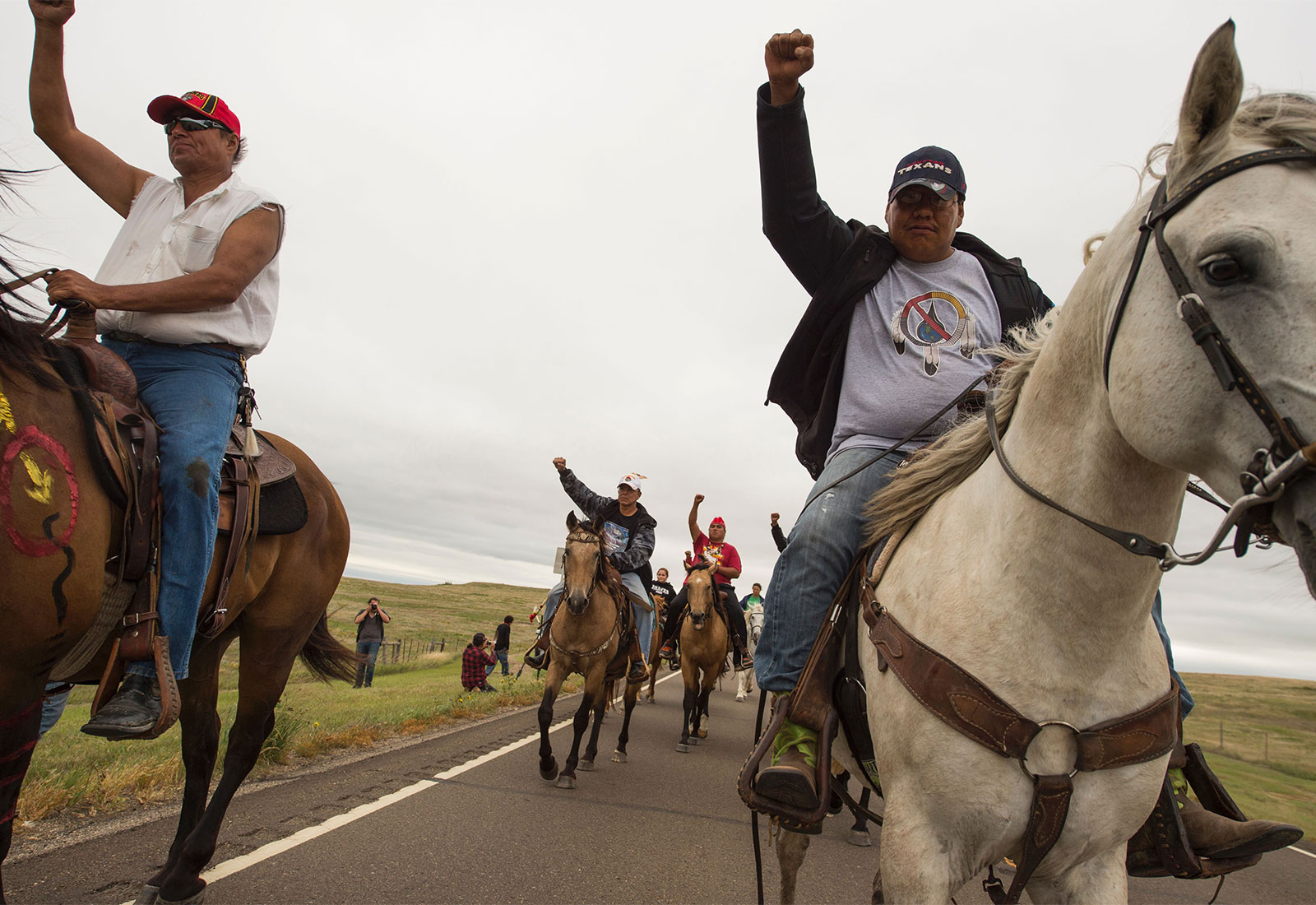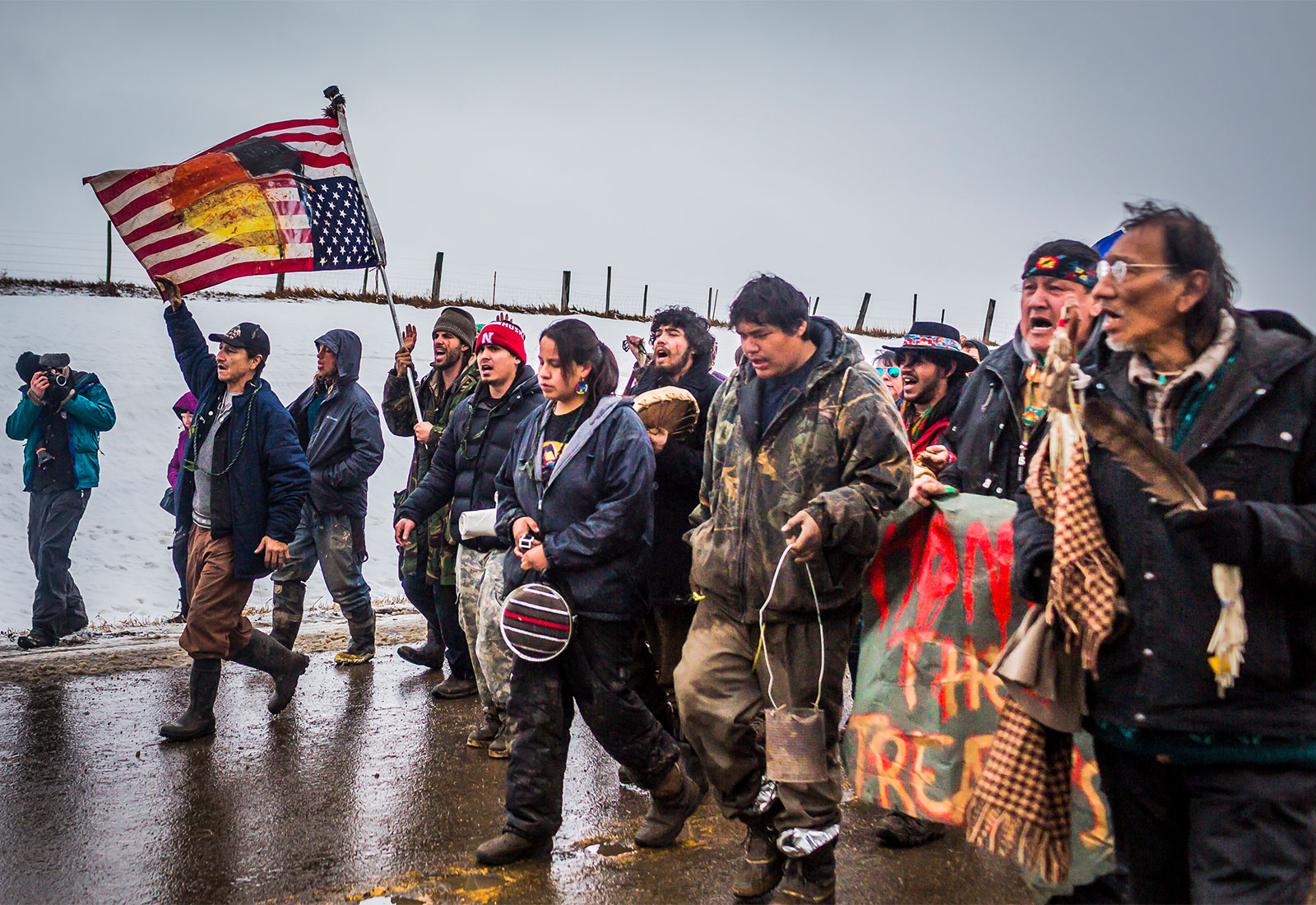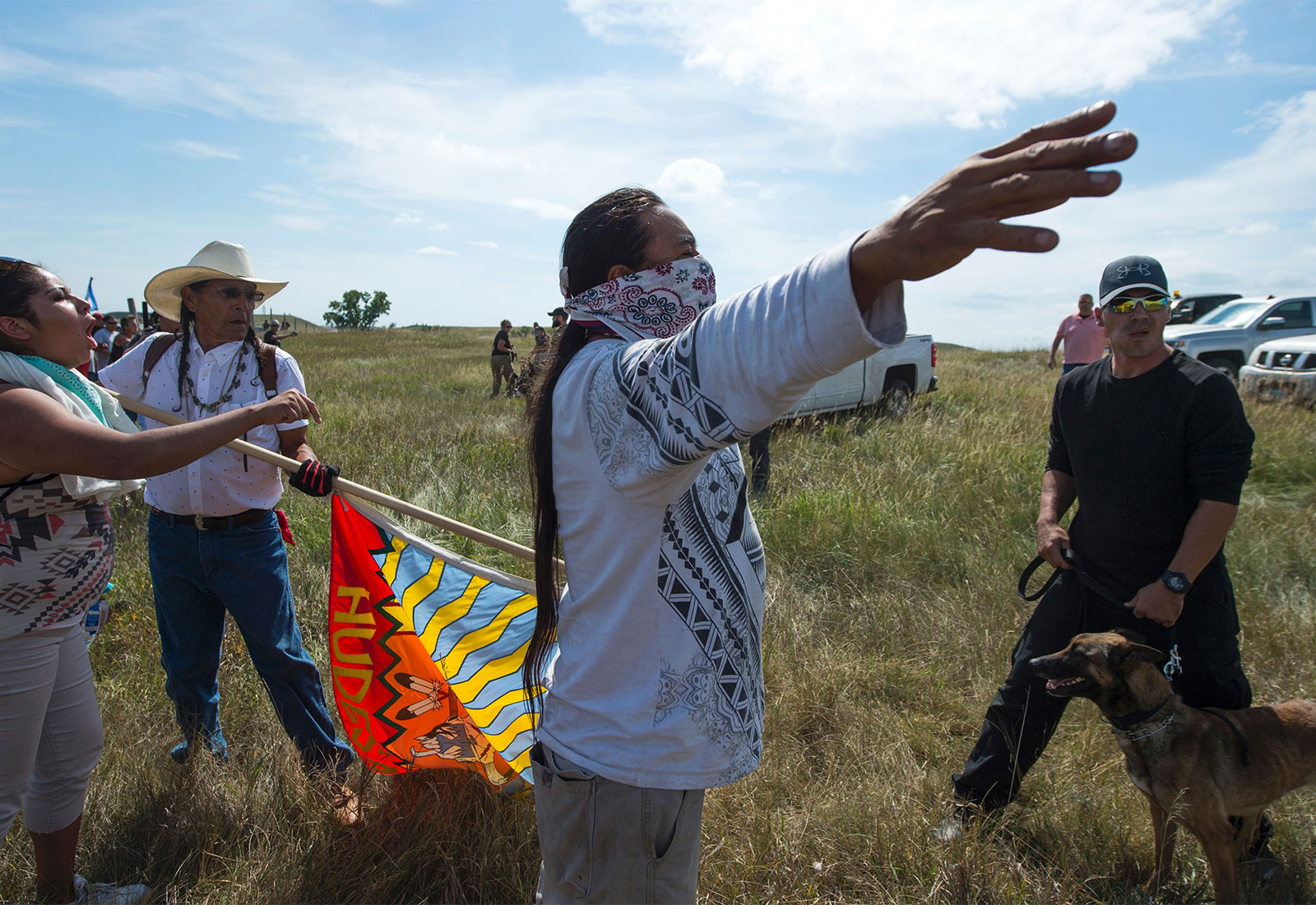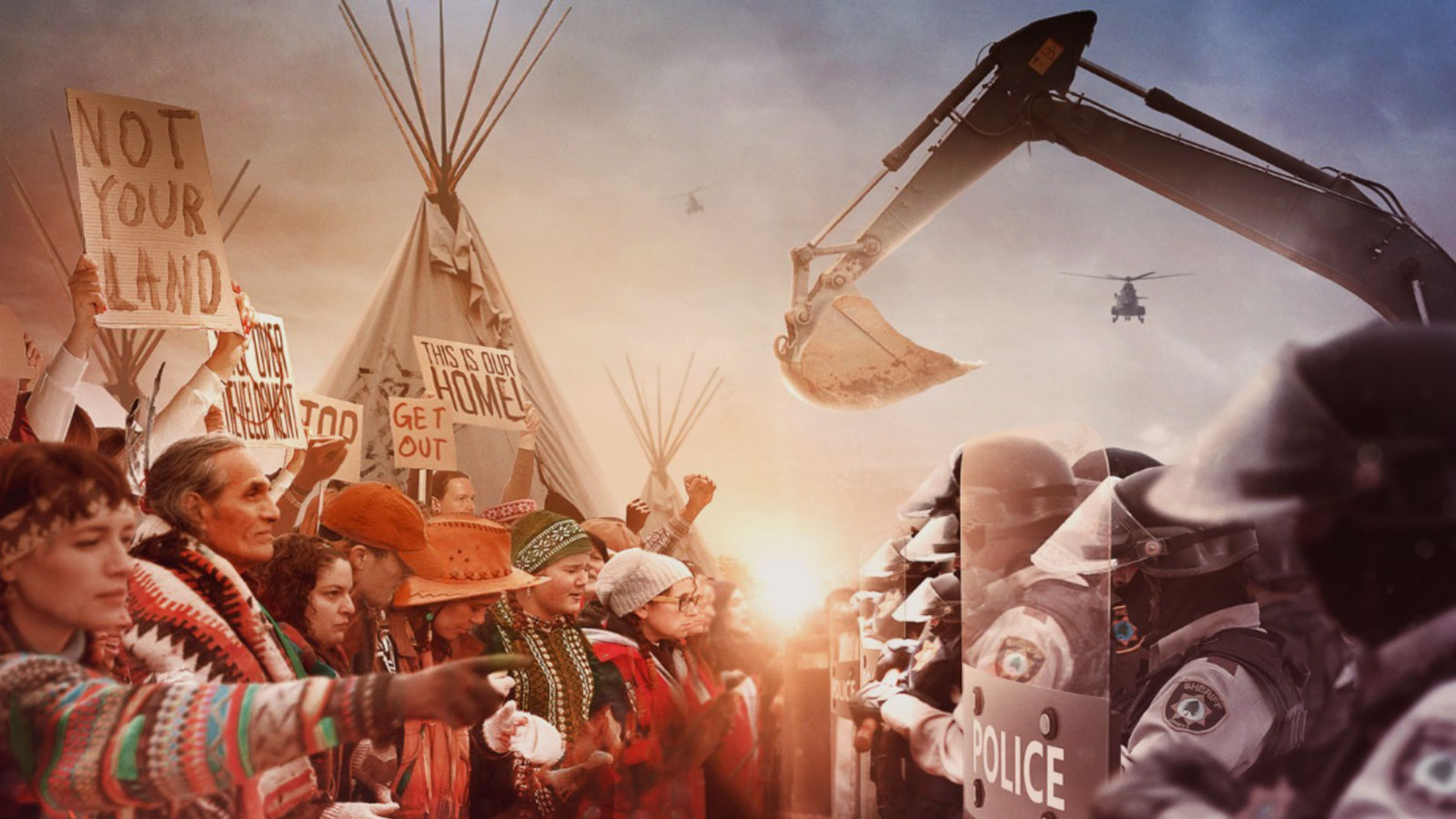I’ve often wondered what a fictional feature film set at Standing Rock, at the height of the 2016 Dakota Access Pipeline resistance, might look like. What about, for instance, an unlikely-allies narrative about two Indigenous people who dislike each other but are forced to work together to fight the pipeline? What about a coming-of-age story about a reconnecting Native trying to find their identity through protest? Or a rom-com where two Indigenous people fall in love surrounded by state violence and chaos?
The upcoming feature-length movie, On Sacred Ground, opts for none of these. Rather, it follows the story of a (white) journalist and a (white) oil company executive who “find themselves on opposite sides of the fight” during the construction of the contentious pipeline. As for the Indigenous activists who led the actual protest effort on the North Dakota reservation, their narratives are shunted to the background in order to allow the main characters to plumb the depths of white guilt.
On Sacred Ground is hardly the first film to focus on Standing Rock. There have been some documentaries on the protests: Awake: A Dream from Standing Rock, co-directed by Myron Dewey, for example. The 2017 Vice television series, Rise, included two full-length episodes, Sacred Water and Red Power. Other full-length documentaries included End of the Line: The Women of Standing Rock* and Black Snake Killaz: A #NoDAPL Story. But to date, there have been surprisingly few “major” works on the subject, and arguably little self-reflection as a nation. This, despite an ever-growing chorus of voices demanding clean water, Indigenous stewardship of natural resources, and climate action — all central themes of the climate crisis, magnified through the actions of Indigenous people at Standing Rock.
On Sacred Ground touches on these ideas, but because the story is told from the white perspective, the needs of white characters and narratives inevitably supersede those of Indigenous stakeholders. How does one even begin to understand the lessons of NODAPL in a film set during the 2016 protests when the main protagonists are white people? Given the explosion of Indigenous-made television and film production occurring at multiple levels of the entertainment industry, On Sacred Ground decision’s to stick with a colonial-first gaze is, at best, puzzling, and, at worst, insulting. One must ask why filmmakers did not read the room.
The set-up is this: Daniel, is a burnt-out journalist dealing with a bad case of post-traumatic stress disorder due to his experience as a reporter covering the war in Iraq. He sleepwalks through his days in Lancaster, Ohio, struggling to fit in with those around him. Played lethargically by William Mapother, Daniel is distant, and inattentive to his wife, Julie, who is expecting a baby. He drives a beat-up Ford and lives in a modest house (because he’s a journalist, it’s safe to say he’s not drowning in riches).
Then comes a phone call from a fancy editor in Houston, played by Frances Fisher. She tells him she spotted his talent based on his previous work and wants to assign him to a story on the Standing Rock for the (fictional) Houston Daily. In reality, Fisher has scouted and recruited Daniel based on his low credit score (438), the knowledge that his last car was repossessed, and the fact that he is a Republican. The paper has oil and gas funding and a deep research budget, and Fisher figures that she can pressure Daniel to write an oil-friendly piece on the anti-pipeline protests.
Thankful for the employment, Daniel throws himself into his new assignment at the Standing Rock Indian Reservation. He’s doing it for the money, to be sure, but it’s clear he’s also seeking some sort of clarity in his life – what exactly that might be, he doesn’t appear to know.
Once at Standing Rock, the plot gets pretty predictable. Daniel meets a sleazy intermediary tasked with guiding him to write that big, oil-friendly story. Somehow, Mariel Hemingway gets mixed into the narrative as a frontline activist, as does Irene Bedard, who plays a matriarchal-type activist named Mary Singing Crow. Daniel gets a crash course on how to act at the makeshift camp and becomes gradually aware of the significance of the story he’s writing and the nuance it demands. Needless to say, the story he discovers is not as oil-friendly as his employer’s funders would have him believe.
Films like On Sacred Ground mean well, and they’ve meant well for a while. I’m reminded of the well-intentioned 2017 film Neither Wolf Nor Dog, where the white protagonist spends the entire run time grimacing after learning the “real” story of how America has treated Indigenous people — a revelation that, when presented to Indigenous viewers or individuals with even a modicum of education, elicits a reaction of “duh?” Here, William Mapother’s Daniel does much of the same, standing in for white America, carrying a look of confusion and pain throughout nearly the entirety of the movie.
Characters like Daniel are designed as stand-ins for WHITE GUILT. Ostensibly, they shoulder some of the heavy weight of America’s historic and ongoing human rights abuses and responsibility for the crushing climate crisis, but that form of atonement leaves little space for nuance when the narrative favors didacticism over true representation. Many viewers may be on board with the idea that the United States has an unhealthy love for oil, but do we need another film about how white people feel guilty about it — especially one set at one of the most important Indigenous events in recent history, at a place where the images of resistance are still seared into our collective memory? Can a film about Standing Rock without Indigenous people at the forefront succeed on any level? And perhaps most importantly, can white people make films like this and not make it about themselves? Of course not.



Actual Indigenous protesters at Standing Rock demonstrate against the Dakota Access Pipeline in 2016. ROBYN BECK / AFP via Getty Images, Michael Nigro / Pacific Press / LightRocket via Getty Images
While co-writers and directors Joshua and Rebecca Harrel Tickell have crafted a story about the price we pay for oil, it unfortunately relies on tired tropes of white guilt and white redemption, retreading that old story we’ve seen so many times before where a white guy is thrown into an “exotic” situation and with the help of ancient Indigenous teachings, goes “off the reservation,” has an epiphany, and finds his truth. In fact, at one point of the film, Frances Fisher’s character actually yells to David Arquette’s Elliot: “He’s gone off the reservation!” The line was so predictable, I was able to say it at the same time she did even on first viewing. I may or may not have howled in amusement.
In the end, the film leans back on the historical record: The Indian activists get arrested, their teepees are burned down, and a lone tear falls down an Indian’s face as they watch the destruction happen. Daniel, meanwhile, watches sadly on his laptop from the comfort of his own home, thus ending his journey. It feels condescending to see the Indians fight valiantly and get punished for it while Daniel gets to go back to his family, file a story about it, and cash a check.
I know I’d rather see other takes on the Dakota Access Pipeline and all the things that occurred there: the love, the loss, the challenges, the inspiration. But I want to see Indigenous people, the ones who took the journey there, tell these stories. I personally know plenty of people who went to Standing Rock in the fight for clean water. And unlike Daniel, once I close my laptop, I know they still exist.
*This article has been corrected to indicate End of the Line: The Women of Standing Rock is a full-length documentary



